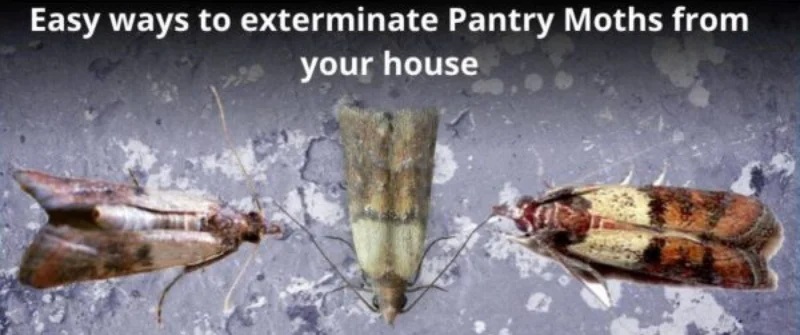Plodia Interpunctella commonly referred to as pantry moth is one of the most problematic pests infesting stored food products. These include all cereal products, pet foods, birdseed, nuts, dried milk, dried fruits, and whole grains. They exist in the house in different stages of life, and getting rid of them can be challenging.
While all the stages of its life cycle are destructive, the greater damage is caused by the larvae. During feeding, the larvae spin silken threads while crawling resulting in webbing the food particles together forming clumps.
This is the greatest sign to know if you have a pantry month infestation. If you record such a presence of them, then you should start getting rid of them despite the fact that pantry moths are not harmful to cause diseases.
How to get rid of pantry moths

- 1. Use of Trichogamma wasps
- 2. Use of diatomaceous earth
- 3. Use of Bacillus thuringiensis insecticide
- 4. Use of Pantry Pest Trap
- 5. Cleaning the pantry thoroughly
- 6. Use of Orange Guard Insecticide
- 7. Use of bay leaves and other herbs
- 8. Sealing up and freezing containers that store food
- 9. Use of botanical insecticides
Not only do pantry moths make the crevices and corners of the cupboards their home, but they also lay eggs in the dry food products too. These eggs hatch into larvae, grow into a pupa and finally burst forth as adult moths.
Sadly, the larval and pupal stages are nearly identical to some grains like brown rice and the moths also end up in our bodies. Therefore, various natural and cost-effective measures exist for the prevention of these moths from food products.
Also Read: Does boiling Purify Water: Kill Bacteria & remove Chemicals?
1. The use of Trichogamma Wasps
Trichogamma wasps are small parasitic wasp with a wingspan of 1/50th of an inch. They have been used for the control of pests for many years.
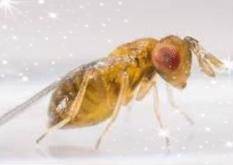
There exist ten species of Trichogamma, which include T. atopovirilia, T. brevicapillum, T. deion, T. exiguum, T. fuentesi, T. minutum, T. nubilale, T. platneri, T. pretiosum, and T. thalense.
The choice of species used depends on the type of pest at hand. These wasps parasitize the pest species by depositing an egg into the egg of the pest.
To locate the pest’s eggs females, use pheromenones and visual signs like color and shape of the egg. After she locates a convenient egg, the female finds out if the egg had been previously parasitized using the antennae.
Also the female determines the size and quality of the egg which determines the number of eggs it will insert.
The wasp’s egg then consumes the contents of the pest’s egg for its development and after a week, the adult wasp emerges.
The Trichogamma life-cycle span is about 9-11 days. During this span, the female wasp seeks out and destroys about 100 pest eggs (10 per day) by laying her eggs inside of it. This method is very safe for human and animal health.
Pros and Cons of using Trichogamma Wasps to Exterminate Months
2. Using Diatomaceous Earth to Pantry Moths
Diatomaceous earth (DE) is fossilized remains of freshwater phytoplankton, algae or small seas creatures referred to as diatoms.
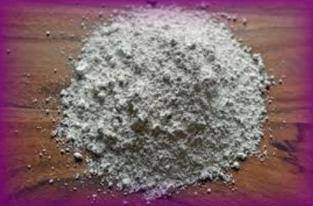
These remains consist of silica ground up into a fine powder and initially, it was used in industries as a dynamite component.
Its effectiveness as a pest control method is through mechanical action.
DE has sharp microscopic edges that act as a desiccant. These sharp edges pierce the outer coating of the insect and absorb their moisture and oils.
This action not only injures the insect but also causes death by causing dehydration through leakage of body fluids. DE is very safe for both human and animal health in fact, it is also used in toothpaste and skincare products.
Pros and Cons of using Diatomaceous Earth to Remove Pantry Months
3. Using Bacillus Thuringiensis Insecticide for Pantry Moth Treatment
Bacillus thuringiensis, a gram-positive bacteria occurs naturally in the gut of the larval stages of moths and butterflies. It consists of spores which are vital to its effectiveness as an insecticide.
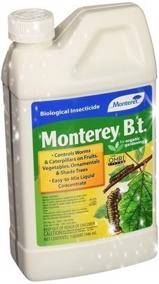
Once sporulation occurs, the bacteria forms crystals of proteins called crystal proteins which in an endotoxin to the insect.
When the larvae stages of the moth ingest the crystal proteins, their alkaline digestive tract denatures the insoluble crystals hence solubilizing them.
This makes them responsive to being cleaved with proteases present in the gut which in turn releases the toxin from the crystals.
Once the toxin is inserted into the insect gut cell membrane, it paralyzes the digestive tract and forms a pore.
Finally, the insect will stop feeding and starve to death. Live bacteria may also conquer the insect which can cause death.
Its safety has been shown to both humans since we lack a digestive system that can break down the crystal proteins and the environment too since once the bacteria is in the soil, the crystal proteins rapidly degrade.
Pros
- It is very effective to larval stages.
- It is a cheap method of pest control.
- It targets a broad range of pests.
Cons
- This insecticide is prone to degradation by sunlight.
- It is not effective when used alone.
- There is very high potential of insects developing resistance towards this insecticide.
4. Using Pantry Pest Traps to Kill Moths
These traps are placed on cabinet shelves, countertops and pantry areas. They contain sex pheromones which attract the male and female moths.

Trapping the male moths will prevent mating and subsequent laying of eggs by the females.
Some traps contain the pheromones inside a glue while some have the pheromone separately from the glue.
For females, these traps are specially designed and contain a special chemical which the females interpret as good areas to lay their eggs.
To achieve effective control, the male traps should be limited to two only as many traps exceeding two will have many pheromones that confuse the males hence not luring any male.
Once the traps fill up with adult males one is advised to replace the trap. This method is safe for both humans and the environment.
However, it is good to know how effective moth traps are so that you can choose the most suitable for your house. Also, read our review on the best pantry moth traps and sprays that really work.
Pros
- It is not fixed in one position hence one can freely move it around the affected areas.
- It is cost effective as it can trap many moths for a long period of time.
- It does not release any toxin or odor that is harmful to human health.
- It is also ready to use and easy to deploy.
Cons
- It must be periodically replaced.
- It is affected by temperature and humidity which reduces its effectiveness.
5. Cleaning the Pantry Thoroughly
Cleaning the pantry starts with completely emptying its contents. All foods showing clear signs of contamination ought to be discarded.
Also, cleaning should be done using a dish towel or sponge in all areas where one can access using hot water and soap. A vacuum cleaner is then used so as to air suck the small eggs and larvae which were inaccessible by the soap and water.
Old liners should be replaced with new ones. Finally, the pantry should be rinsed using vinegar and warm water in a ratio of 1:1 and some drops of peppermint oil should be added.
Peppermint repels the moths due to its menthol contents that cause a cooling sensation when inhaled.
Pros
- It is very cheap.
- It is environmental friendly.
- Does not require any skills or instructions to execute.
Cons
- It does not effectively eliminate all the eggs of the moths as they are very tiny to the naked eye.
- It is tiresome since one spends a lot of energy cleaning up the pantry and if one has a large panty it becomes extensively tiresome.
6. Use of Orange Guard Insecticide Eliminate Pantry Moths
Orange peels are known to have about four times health benefits than the actual orange fruit. Not only is this important to human health but also used as a strong ingredient in the manufacture of insecticides.
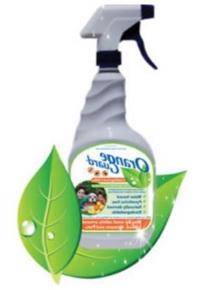
The orange peel contains flavonoids like polymethoxyflavones (PMFs) and hesperidin.
It also contains other phytochemicals like D-limonene that kill and irritate the moths thus keeping them away.
D-limonene is lipophilic possessing high toxic interference with the biochemical, physiological and behavioral functions of the moths.
This compound kills the eggs of the moths instantly it comes into contact with the eggs.
Larvicidal toxicity takes time while in adults it reduces their fecundity hence managing their population. The orange guard is an insecticide that is made from mixing orange peels with water.
This is a very safe method to apply since it is very friendly to humans, other animals as well as the environment in general.
Pros
- It is simple to use.
- It has targets a wide range of insects hence its multi-purpose.
- It has a fresh citrus scent that can be used as air freshener.
- It can be used around food since it consists of the orange peel and water.
- It does not leave stains once applied.
Cons
- They target a wide range of insects thus it can target species that were not intended for targeting.
- Since it is an insecticide like any other, resistance cases arise once they are used for long periods of time repeatedly.
7. Using Bay Leaves and Other Herbs
Bay leaves, eucalyptus, lavender, wormwood, and tansy are natural repellants to the pantry moths. The herbs just like peppermint contain phytochemicals like terpenes and essential oils.
These phytochemicals mainly contain sharp and pungent smell that naturally repels the moths.
At the same time, the herbs can be placed on pantries in every corner of the shelves where food is stored or even placed in the containers storing the food since they have no effect on dry food. It is very safe to use in humans.
8. Sealing up and Freezing Food Storage Containers
All containers storing food should be airtight. They include plastic, metal or glass containers. In case that the food was already infested with pantry moths, these airtight containers will prevent them from spreading to other foods.
Once the foods are sealed up, freezing should be done for one week. The eggs of the pantry moths cannot survive in cold temperatures hence the eggs will be non-viable. This method is very safe for humans as freezing does not affect the quality of food.
9. Using Botanical Insecticides to Control Pantry Moths
Botanical insecticides are chemicals occurring naturally and are extracted in plants or minerals. Most plants contain insecticidal properties. Examples of these insecticides include pyrethrum, rotenone, and sabadilla.
These insecticides work by altering the sodium and potassium ion exchange and thus disrupts the normal transmission of nerve impulses. By doing this, they are able to get rid of pantry moths by killing the adults.
This causes paralysis and finally death of the insect. Botanical insecticides are considered as the second line of defense when the natural methods are ineffective or in cases of advanced moth infestations in the kitchen.
How to Prevent Pantry Moths from Getting into the House
As the old cliché says, “Prevention is better than cure”, the best way to get rid of pantry moths is by preventing an infestation in the first place.
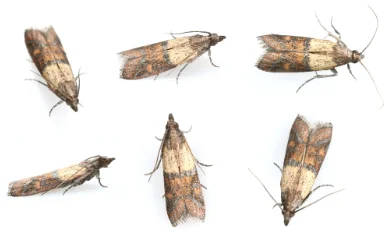
Many foods that are purchased contain eggs of pantry moths, which can be a nuisance. It is recommended that you know such how moths enter your house so as to effectively apply methods of avoiding them.
This comes from their ability to contaminate food which is expensive to restock.
Since there is no way to prevent the food bought from the risk of pantry moths, proactive measures should be taken to prevent these moths from fully infesting the house.
Several methods of preventing these moths in the house include:
1. Tight Sealing and Temperature Control
All cereal products purchased should be placed in airtight containers to prevent these moths from coming out and causing huge infestations. Pantry moths cannot survive in low temperatures too.
Therefore, freezing should be done for one week to kill these moths. In addition, the eggs of the pantry moths cannot survive in cold temperatures hence the eggs will be non-viable.
2. Smart Shopping
To prevent the infestation of pantry worms, one should buy the quantities of cereal that can be utilized within a few weeks.
3. Use of Pest Trap
These traps are an effective way of keeping the pantry moths away. They can be placed close to the door of the house to trap any incoming males or females.
4. Using Insecticides Regularly
This is always the last resort when it comes to preventing any kind of pest. Despite their effects, insecticides are one of the best ways to keep these pests away.
Regular spraying could keep these pests at bay and prevent them from entering the house.
Will Pantry Moths Die without Food?
Without food, pantry moths will definitely die. After the eggs have hatched into the larvae, the larvae enter a rapid feeding stage which builds up a reserve during the less active pupal stage.
The larvae, therefore, will find their way into old boxes that had stored food to get the most meager scraps of food. As time goes by these moths require more food.
How Long it takes for Pantry Moth to Die
Depending on the method used for control, time for their eradication varies. For example, the use of diatomaceous earth takes a minimum of 24 hours if the compound is still effective and a maximum of five days in cases where the compound is contaminated with water.
Other methods like the use of insecticides are instant. Therefore, the average time to completely get rid of pantry moths is between 3 to 10 days.
Also Read: Best Freestanding Kitchen Sinks with Cabinet: single or double
Conclusive Summary
Pantry moths are hazardous and result in a lot of contamination to stored food products. Despite them not causing diseases or any harm to humans, they cause damage to various cereals and grains and their control is quite expensive.
It is for this reason that you should always learn how to get rid of pantry moths from your house and maintain cleanliness. Control should also be limited to environmental and human-friendly ways.
FAQs on Controlling Pantry Moths in your House
What Essential Oil Gets Rid of Pantry Moths?
There are essential oils that can help to keep moths away. However, before you use the essential oils, it is vital to ensure the home is clean
Clean and dust all your clothes and woolen blankets, including the off-season ones in storage. Make sure you vacuum weekly and store grain-based foods in sealed jars.
Essential oils are one of the most effective options to keep moths and insects away. The best essential oils to get rid of pantry moths include:
- Lavender essential oil
- Rosemary essential oil,
- Peppermint essential oil
- Lemongrass Essential oil.
- Eucalyptus Essential oil
- Lemon essential oil
Does Cedar Repel Pantry Moths? What Repels Pantry Moths?
Essential oils are natural and effective moths, bugs, and insects’ repellents.
Yes. Cedar wood is an effective moth repellent; place cedar chips or blocks in strategic areas. Also, cedar oil is among the best and most frequently used essential oils for repelling moths and other insects.
You can also use pungent bay leaves to repel pantry moths. Either fresh or dry bay leaves work. However, you will need more of the dry leaves. Place the bay leaves inside cupboards and canisters.
You can also keep the bay leaves in a shallow open container and scatter some on the shelves to repel moths and insects. It is therefore good to know how they enter the house so as to know how to prevent them.
Also Read: Best Sink Paints for Kitchen and Bathroom sinks: Review 2021
Does Vinegar Kill Moth Larvae?
Yes. White vinegar is a robust natural cleaner that can kill moth eggs and larvae. When you use vinegar to clean, it changes the pH of everything on the surfaces you scrub.
Vinegar can kill any moth eggs and larvae and also kills other pantry pests’ larvae in your kitchen. Therefore, you can use a vinegar solution to clean and sanitize your home.
Besides the kitchen, clean the bedroom, including all wardrobe surfaces, the undersides of shelves, drawers’ liners and slides, and inside the drawers and cabinets.
Also, go over hooks, edges, and grooves. Spray the solution in drawers and cabinets to prevent moth infestations. For extra protection, add a few drops of essential oil.
Meanwhile, watch how to eliminate pantry pests and moths from your house,


As a homeowner, I am specifically keen on home improvement. I am passionate about homes, yards, and home improvement. I blog on home ideas and reviews on solutions that make homes better.
